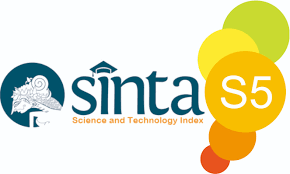Faktor-Faktor Yang Mempengaruhi Agresivitas Pajak
Abstract
Penelitian ini bertujuan untuk menguji dan menganalisis pengaruh profitabilitas, likuiditas, dan
leverage terhadap agresivitas pajak. Penelitian ini menggunakan pendekatan kuantitatif dengan data
sekunder yang diperoleh dari situs resmi BEI. Dari 103 perusahaan dalam populasi, sebanyak 29
perusahaan dipilih sebagai sampel melalui teknik purposive sampling, menghasilkan 145 data
observasi yang dianalisis. Analisis dilakukan menggunakan regresi data panel dengan pendekatan
Common Effect Model (CEM) melalui software EViews 12. Temuan studi menunjukkan bahwa
agresi pajak dipengaruhi secara negatif oleh profitabilitas, tetapi tidak banyak dipengaruhi oleh
likuiditas atau leverage. Secara simultan, ketiga variabel tersebut memiliki pengaruh terhadap
agresivitas pajak. Kebaruan (novelty) dari penelitian ini terletak pada pendekatan kontekstual yang
digunakan, yaitu dengan menganalisis data terkini dari subsektor pertambangan basic material
dalam lanskap industri yang dipengaruhi regulasi pemerintah dan volatilitas harga komoditas. Selain
itu, penelitian ini juga mempertimbangkan interaksi antar variabel keuangan dalam satu model
analisis, yang belum banyak dikaji dalam konteks agresivitas pajak di sektor ini. Implikasi dari
temuan ini menunjukkan perlunya pengawasan lebih intensif terhadap perusahaan dengan
profitabilitas tinggi oleh otoritas pajak, serta pentingnya strategi manajemen pajak yang
komprehensif oleh perusahaan. Investor juga disarankan mempertimbangkan praktik agresivitas
pajak sebagai bagian dari penilaian tata kelola perusahaan.
This study aims to examine and analyze the influence of profitability, liquidity, and leverage on tax
aggressiveness. This study uses a quantitative approach with secondary data obtained from the official IDX
website. Of the 103 companies in the population, 29 companies were selected as samples through a purposive
sampling technique, resulting in 145 observational data points for analysis. The analysis was conducted using
panel data regression with the Common Effect Model (CEM) approach using EViews 12 software. The results
show that profitability has a negative effect on tax aggressiveness, while liquidity and leverage do not show
a significant effect. Simultaneously, all three variables influence tax aggressiveness. The novelty of this study
lies in the contextual approach used, namely by analyzing recent data from the basic materials mining
subsector within an industrial landscape influenced by government regulations and commodity price
volatility. Furthermore, this study also considers the interaction between financial variables within a single
analytical model, which has not been widely studied in the context of tax aggressiveness in this sector. The
implications of these findings indicate the need for more intensive oversight of companies with high
profitability by tax authorities, as well as the importance of a comprehensive tax management strategy by
companies. Investors are also advised to consider tax aggressiveness practices as part of their corporate
governance assessment.




